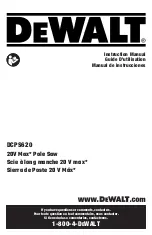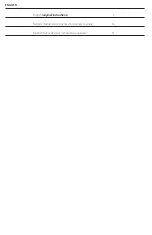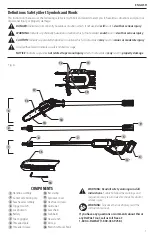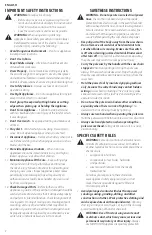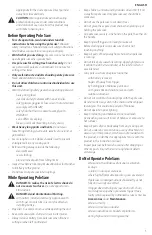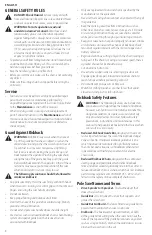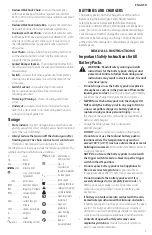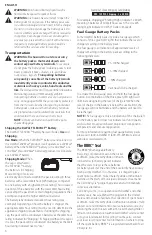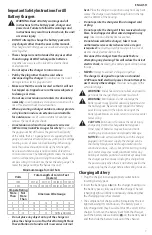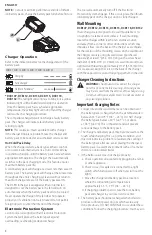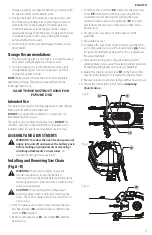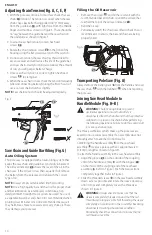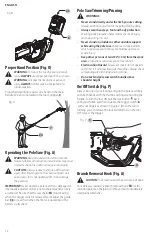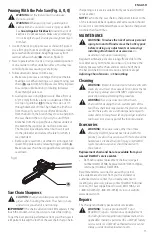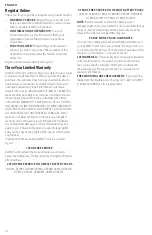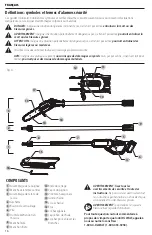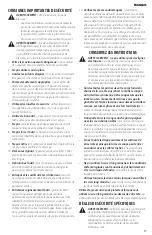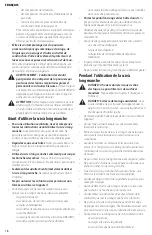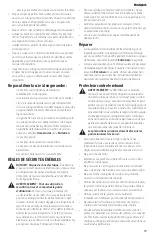
English
5
•
Reduced Kickback Chain -
A chain that complies
with the kickback performance requirements of ANSI
B175.1–2012. (when tested on a representative sample of
chain saws.
•
Reduced Kickback Guide Bar -
A guide bar which has
been demonstrated to reduce kickback significantly.
•
Replacement Saw Chain -
A chain that complies with
kickback performance requirements of ANSI B175.1–2012.
when tested with specific chain saws. It may not meet
the ANSI performance requirements when used with
other saws.
•
Saw Chain -
A loop of chain having cutting teeth, that
cut the wood, and that is driven by the motor and is
supported by the guide bar.
•
Spiked Bumper (Spike) -
The pointed tooth or teeth for
use when pruning to pivot the saw and maintain position
while sawing.
•
sw
itch -
A device that when operated will complete or
interrupt an electrical power circuit to the motor of the
chain saw.
•
Switch Lockout -
A movable stop that prevents
the unintentional operation of the switch until
manually actuated.
•
Trimming (Pruning) -
Process of cutting limbs from
a tree.
•
Undercut -
An upward cut from underside of a log or
limb. This is done while in normal cutting position and
cutting with top of guide bar.
Storage
1 .
Store indoors.
The best storage place is one that is cool
and dry away from direct sunlight, excess heat or cold and
out of the reach of children.
2 .
Always reduce the tension off the chain again after
finishing work. The chain contracts as it cools down.
If tension is not reduced, it can damage the saw.
The label on your tool may include the following symbols. The
symbols and their definitions are as follows:
V ......................... volts
Hz .......................hertz
min .....................minutes
or DC ......direct current
...................... Class I Construction
(grounded)
…/min ..............per minute
BPM ....................beats per minute
IPM .....................impacts per minute
RPM .................... revolutions per
minute
sfpm ................... surface feet per
minute
SPM ....................strokes per minute
A .........................amperes
W ........................watts
or AC ...........alternating current
or AC/DC .... alternating or
direct current
...................... Class II
Construction
(double insulated)
no .......................no load speed
n .........................rated speed
......................earthing terminal
.....................safety alert symbol
.....................visible radiation
..................... wear respiratory
protection
..................... wear eye
protection
..................... wear hearing
protection
..................... read all
documentation
BATTERIES AND CHARGERS
The battery pack is not fully charged out of the carton.
Before using the battery pack and charger, read the
safety instructions below and then follow charging
procedures outlined. When ordering replacement battery
packs, be sure to include the catalog number and voltage.
Your tool uses a
D
e
WALT
charger. Be sure to read all safety
instructions before using your charger. Consult the chart
at the end of this manual for compatibility of chargers and
battery packs.
READ ALL INSTRUCTIONS
Important Safety Instructions for All
Battery Packs
WARNING: Read all safety warnings and all
instructions for the battery pack, charger and
power tool. Failure to follow the warnings and
instructions may result in electric shock, fire and/
or serious injury.
•
Do not charge or use the battery pack in explosive
atmospheres, such as in the presence of flammable
liquids, gases or dust.
Inserting or removing the battery
pack from the charger may ignite the dust or fumes.
•
NEVER force the battery pack into the charger. DO
NOT modify the battery pack in any way to fit into
a non-compatible charger as battery pack may
rupture causing serious personal injury.
Consult
the chart at the end of this manual for compatibility of
batteries and chargers.
• Charge the battery packs only in designated
D
e
WALT
chargers.
•
DO NOT
splash or immerse in water or other liquids.
•
Do not store or use the tool and battery pack in
locations where the temperature may reach or
exceed 104 °F (40 °C) (such as outside sheds or metal
buildings in summer).
For best life store battery packs in
a cool, dry location.
NOTE: Do not store the battery packs in a tool with
the trigger switch locked on. Never tape the trigger
switch in the ON position.
•
Do not expose battery pack or tool/appliance to
fire or excessive temperature.
Exposure to fire or
temperature above 265°F (130°C) may cause explosion.
•
Do not incinerate the battery pack even if it is
severely damaged or is completely worn out.
The
battery pack can explode in a fire. Toxic fumes and
materials are created when lithium ion battery packs
are burned.
•
If battery contents come into contact with the skin,
immedicately wash area with mild soap and water.
If battery liquid gets into the eye, rinse water over the open
eye for 15 minutes or until irritation ceases. If medical
attention is needed, the battery electrolyte is composed of
a mixture of liquid organic carbonates and lithium salts.
•
Contents of opened battery cells may cause
respiratory irritation.
Provide fresh air. If symptoms
persist, seek medical attention.

